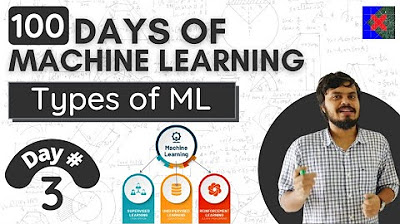Learning Algorithm Of Biological Networks
Summary
TLDRThe video explores the concept of predictive coding, a machine learning algorithm inspired by the brain’s natural learning process. Unlike back propagation, which requires global coordination and separate learning phases, predictive coding allows neurons to predict, compare, and adapt locally in parallel. This approach aligns with biological principles of learning, providing computational advantages such as avoiding catastrophic forgetting and offering more efficient processing. The video also highlights how predictive coding could potentially revolutionize AI by mimicking the brain's continuous and autonomous learning process, making artificial systems more resilient and efficient.
Takeaways
- 😀 Predictive coding frames inference and learning as an energy minimization problem, where each layer predicts the activity of the layer below.
- 😀 Unlike backpropagation, which requires global coordination and separate phases for computation and learning, predictive coding operates as a continuous, parallel process.
- 😀 In predictive coding, neurons predict, compare, and adapt simultaneously, making it more efficient and biologically plausible than backpropagation.
- 😀 Predictive coding offers local autonomy, where each neuron only responds to local prediction errors, making the algorithm highly parallelizable.
- 😀 The local nature of predictive coding allows for more efficient learning and avoids issues like catastrophic forgetting, which can arise in backpropagation-based systems.
- 😀 In predictive coding, the network gradually refines its internal model of the world by adjusting weights according to local update rules until it reaches equilibrium.
- 😀 The energy minimization process in predictive coding enables networks to generate compressed representations of data, useful for generative tasks.
- 😀 Predictive coding aligns with observed biological plasticity rules, which helps in understanding how the brain learns and adapts effectively.
- 😀 By clamping the topmost layer in supervised learning tasks, predictive coding can be used for classification by discovering optimal input-output mappings.
- 😀 The theoretical advantages of predictive coding suggest it could lead to better solutions than backpropagation, preserving previously learned information while adapting to new data.
Q & A
What is the main focus of the video?
-The video discusses predictive coding as an alternative to traditional back propagation in neural networks, exploring its biological plausibility and potential advantages for machine learning.
How does predictive coding differ from back propagation?
-Unlike back propagation, which requires global coordination and separate computation and learning phases, predictive coding operates as a continuous parallel process, with neurons independently predicting and adjusting based on local errors.
Why is back propagation considered biologically implausible?
-Back propagation is considered biologically implausible because the brain does not pause its computational processes during learning and doesn't use global error signals to adjust the network. The brain operates more efficiently with continuous, parallel error-correction mechanisms.
What role do prediction errors play in predictive coding?
-In predictive coding, neurons adjust based on prediction errors—the difference between the predicted activity and the actual activity. These errors guide the learning process, leading to a refined internal model of the world.
How does the hierarchical structure work in predictive coding?
-In predictive coding, higher layers of the network predict the activity of lower layers. When a prediction is incorrect, an error signal is generated and fed back to adjust the network's weights to reduce the error.
What are the benefits of local autonomy in predictive coding?
-Local autonomy in predictive coding allows each neuron to respond independently to local prediction errors, making the system highly parallelizable and computationally efficient. This approach also avoids the need for global coordination.
What is catastrophic forgetting, and how does predictive coding address it?
-Catastrophic forgetting refers to the loss of previously learned information when a model is trained on new data. Predictive coding's local update rules help preserve existing knowledge while learning new information, reducing the risk of catastrophic forgetting.
How does predictive coding handle both generative tasks and supervised learning?
-In generative tasks, predictive coding allows the network to synthesize new images by running to equilibrium with fixed weights. In supervised learning, the network adjusts its weights based on prediction errors, with the topmost layer being clamped to the desired label for classification.
What makes predictive coding potentially more efficient than back propagation?
-Predictive coding's local update rules enable continuous, parallel learning, avoiding the need for separate forward and backward passes required in back propagation. This can result in more efficient computation and faster adaptation in certain settings.
What is the significance of the energy minimization problem in predictive coding?
-The energy minimization problem in predictive coding frames the learning process as one of reducing prediction errors, akin to minimizing energy in physical systems. This helps the network adjust in a way that lowers discrepancies between predicted and actual neural activity.
Outlines

This section is available to paid users only. Please upgrade to access this part.
Upgrade NowMindmap

This section is available to paid users only. Please upgrade to access this part.
Upgrade NowKeywords

This section is available to paid users only. Please upgrade to access this part.
Upgrade NowHighlights

This section is available to paid users only. Please upgrade to access this part.
Upgrade NowTranscripts

This section is available to paid users only. Please upgrade to access this part.
Upgrade NowBrowse More Related Video

DL.1.1. Fundamentals of Deep Learning Part 1

Types of Machine Learning for Beginners | Types of Machine learning in Hindi | Types of ML in Depth

The Fundamentals of Machine Learning

Gradient descent simple explanation|gradient descent machine learning|gradient descent algorithm

Faculty Interview: Meet Dr. Ting Hu

Aula 2 - Inteligência artificial e machine learning com foco em predição
5.0 / 5 (0 votes)